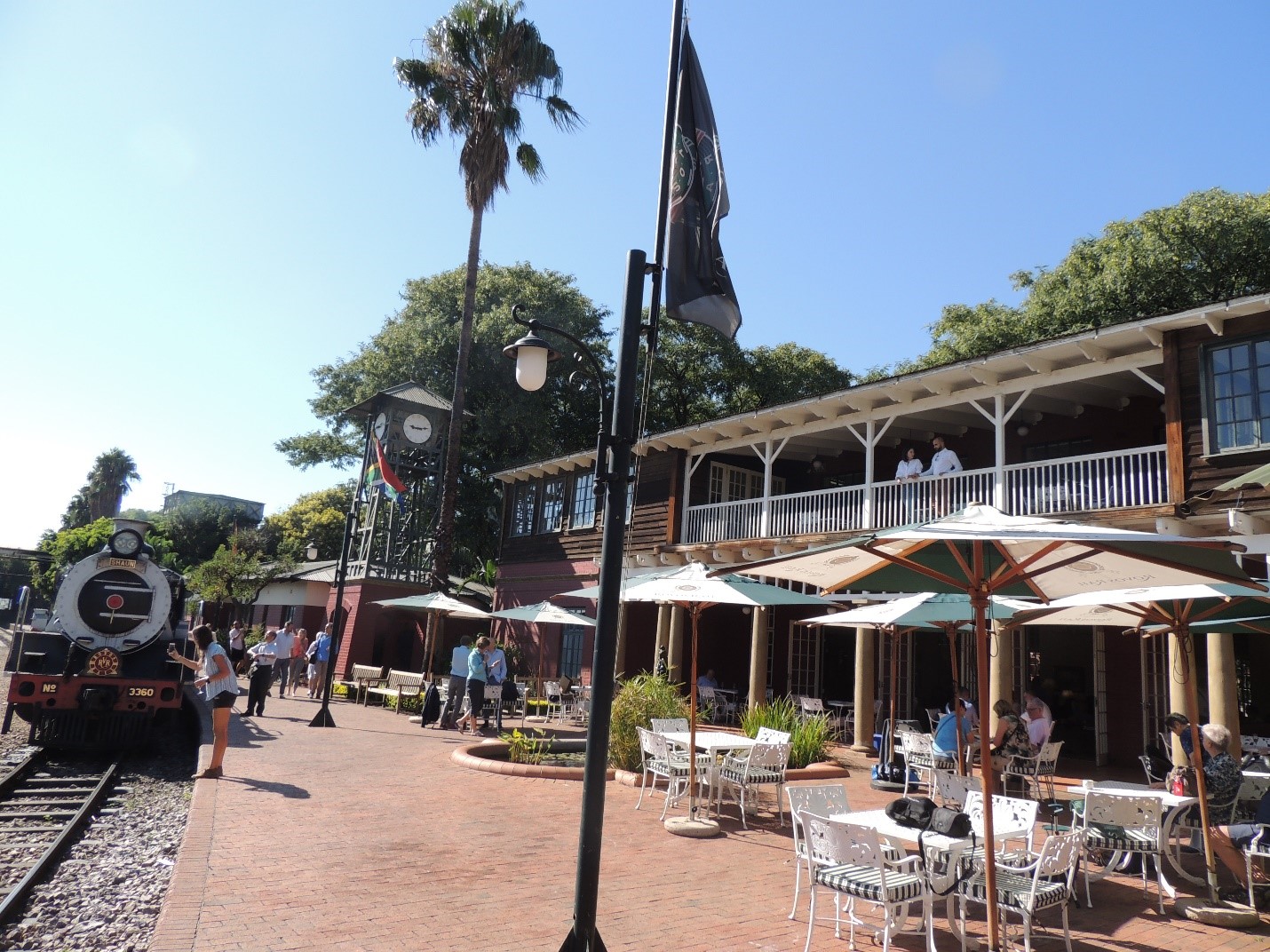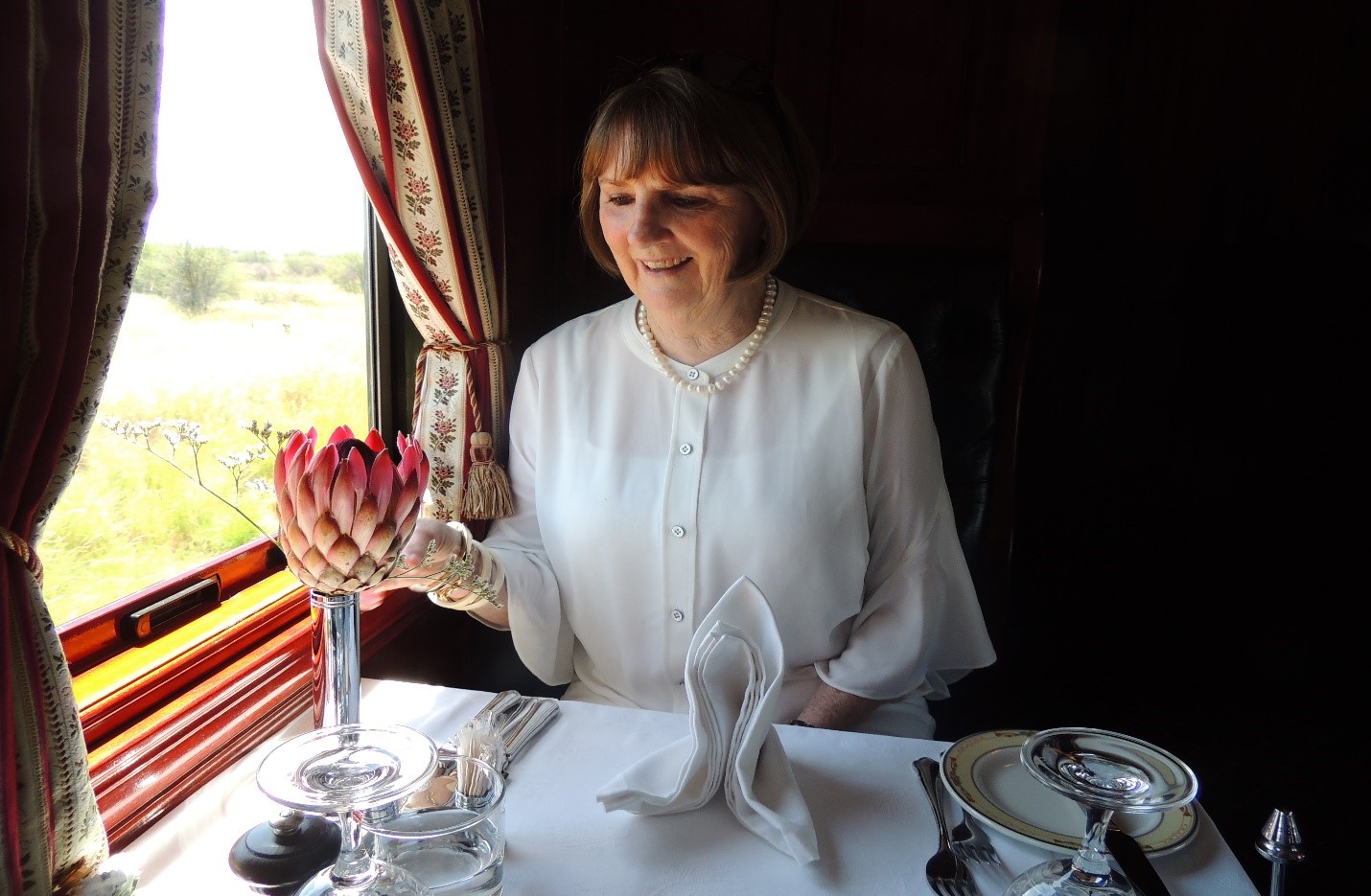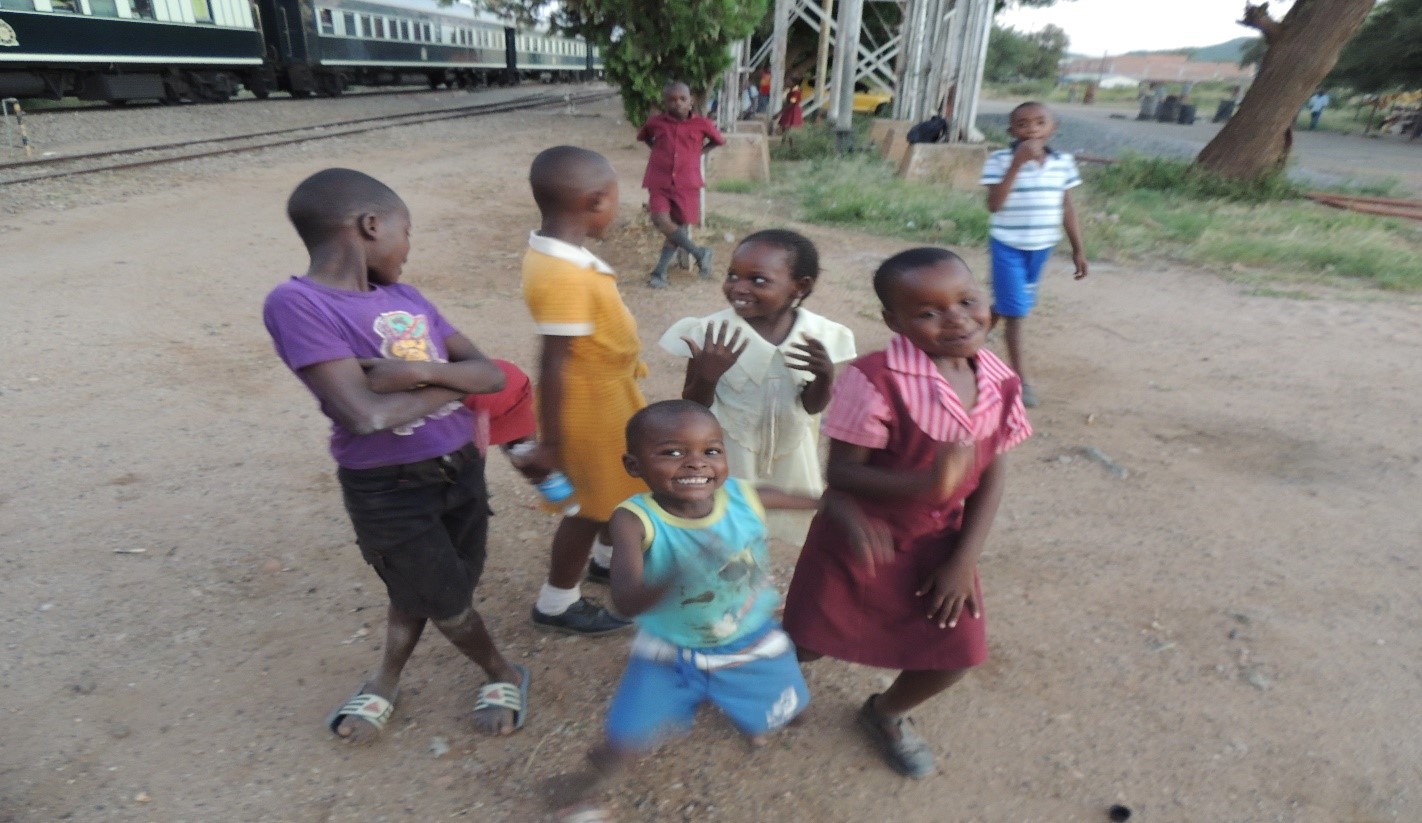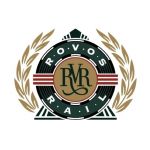Pretoria to Victoria Falls with Rovos Rail
The Rovos Rail journey from Pretoria to Victoria Falls has certainly become a firm favourite. We recently had guests, Mr and Mrs Hume, who travelled on this journey in celebration of their 80th birthdays! They took the time to send us a lovely e-mail but also a really kind and enthusiastic review on their trip.
Thank you Mr and Mrs Hume and happy birthday from all of us at Rovos Rail!
Rovos Rail was simply transporting. In so many ways. Born of the dreams of a tall, handsome visionary who dreamt of having a private refurbished train on which to take his family on a tour of South Africa, it soon evolved into one of the most luxurious trains in the world.
Rohan Vos (pronounced “Foss”), having obtained permission from South African Railways to operate a private train, soon found that the myriad of petty fees and costs levied by the state operator, made a private train simply unaffordable. So, not to be daunted, Vos expanded his idea into a commercial tourist train. Following his passion of transforming derelict rail carriages into masterpieces of mahogany-paneled Edwardian grandeur, finished with the finest brass and silver trimmings and crimped, etched glass lampshades, Vos has created a traveling jewel which affords the discerning traveler the chance to glide through the rugged African veldt while being pampered in the best ways known to man.
Brother David had driven us from his home in Johannesburg to the start point. But at first we had trouble finding it, nestled as it was under unlikely tall palm trees in a disused section of Pretoria’s railyards. Adding to its sense of mystery. Then there it was, a colonial-era station house, transformed into a spacious, gracious lounge filled with leather couches and period pictures, all gently blown by the breezes of twirling, broad-bladed ceiling fans. Young waitresses plied the guests with trays of champagne in frosted flutes. We had arrived. The sense of expectation was electric.

Vos himself seems to treat the departure of every train as a landmark event in his family’s history. He was there in person to shake every hand and wish everyone a good time. Before boarding he devoted almost a full hour to explaining the history of ROVOS, and to giving his guests a tour of the workshops adjoining the station house, where coaches are refurbished and train pieces from bogey wheels to window latches are serviced and repaired. For our amusement he had arranged for one of the original steam engines to be drawn up at the siding. We crawled all over it, amid its wisps of escaping steam, like kids on a Jungle Jim, striking poses for each other’s cameras.
Eventually, we boarded. Our bags already loaded into our spacious cabin, we soaked up every detail of the luxury hat engulfed us. The broad double bed, the warmth of the wood panels, the space, the work table, the adjoining shower room and toilet, the ample hanging and cupboard space, the mini-bar, to be stocked up as we ordered. What else could there be? We were soon in the Observation Car, chilled Chenin Bancs in hand, the logoed cut-crystal glasses glistening like golden orbs against the arid grassy plains passing beyond the windows.
Lunch was as much a dream as a meal. We struggled to balance our focus between the scrumptiousness of the food and wine and the beauty of the fittings in the ornate Dining Car, with its tasseled velvet curtains at each window. Mini-quiche served with Hamilton Russell Constantia Chardonnay was followed by grilled salmon on rice with asparagus accompanied by Sutherland Saugivnon Blanc. All served under the regal audience of a large Protea flower, one per table, South Africa’s unique symbol of enduring elegance. Echoed by the pleasure of Meriel’s ethereal presence . Butter balls in a silver-plated dish completed the picture.

As the train gently lurched its way forward my history came into focus. We crossed the Limpopo at Beit Bridge, named after Sir Alfred , Cecil Rhodes’ minor partner in the De Beers diamond company, . The fund he established helped finance my Doctorate at Oxford. Bulawayo, place of my birth, was up ahead. First would come Collen Bawn, famous century-old quarry and cement plant, then Gwanda, Balla Balla, and, finally, Essexvale where, about a hundred years ago, my father Denny cycled out with his gold pan to prospect the streams.

We stopped at Gwanda to visit a curio market. Besieged by politely badgering African kids the Rovos guests shuffled from stall to stall against a backdrop of African singing as a troupe of young locals vigorously danced for us.
By now dusk had fallen and I knew I would not actually see these places, but would be in them. Night would steal them from me as history had already done, almost. So that night we slept near Bulawayo without seeing it, at Mpopoma. After sunrise our journey continued and more names, each with memories, came into view: Pasi Pas where Denny had taken me one day in the late 1940s to buy sandstone from the quarry to build our house on Norfolk Road; Nyamandhlovu (“flesh of the elephant”) where my Plumtree classmate Mike Wood’s father had been Native Commissioner; then Saw Mills once the center of Rhodesia’s hardwood industry (Yellowwood an Muqua), now standing weeded and overgrown, grazed by a small herd of motley looking goats. Gwaai River would be next, followed by Dett and Hwange where we are to stop for a game drive.

The game drive exceeded all expectations. Starting early on open, tiered-seat Jeeps (supplied by The Hide) there was a sense of exhilarating excitement cruising across Hwange’s endless grassy khaki-colored grasslands. We saw few animals to start with. It was still too warm for them to start their evening browsing. There were a couple of giraffes and a lone Impala bull, partly hidden in the shade of thickets, and some bird life but not much else. Cleophas the guide had asked us what we would like to see. We all said, predictably, “The Big Five”. One guest said “Cheetah” and I added “Kudu”. “The Big Five not possible” he said, “because Hwange no longer has rhinos. Cheetahs not guaranteed and Kudu unlikely but we can hope..” He finished. He said we could see lions but they were 30Kms away. We said that was too far. After a while, deep into the plain we came across a muddy watering hole in which there was a lone elephant bull. It stood motionless like an apparition, its tusks completely covered in glistening black mud like a dark chocolate version of itself. “This bull” the guide explained “has probably been estranged from the herd. He may be in decline and is facing his own extinction in what will be a lonely life from now on.” We left him alone and moved to another water hole with four more younger bulls, caking themselves in mud and dust. Cleophus explained that, once thus covered and caked, they would find a tree and rub their sides against it. Any ticks and other parasites apparently get ripped off the elephant with the caked mud. Tuskers toilet.
As we left the elephants another viewing Jeep closed on us, saying that the reported lions were still at the same place. We decided to go there. On arrival we saw only a small green patch in the sea of golden grss, with sme scattered bushes and a fallen tree trunk. The we saw that there were two huge male lions, one lying on his side snug into the bush for the shade, the other stretched out below the fallen tree trunk. We came within a few yards from them. They showed no interest in us at all. Occasionally the one would look out into the distance across the plane. We did not know it at the time but he was eying his mates, three lionesses hidden in the grass a half mile away. As we watched the lion under the tree trunk rolled into its back, turned its head lazily and gazed at us with his head upside down. Sizing us up from down under.
Before long, as the sun lost its heat, sinking towards the horizon and throwing a liquid gold light across the glowing pain, we suddenly saw that it had come alive with animals. Herds of Impala appeared from nowhere, there were giraffe gliding like glinting cranes through a patch of trees, we saw two Kudu does, and there was a family of waterbuck not far from where the lions lay. Cleophus explained the waterbuck were not afraid of lions, partly because they knew did not favor the taste of their flesh, but also because, strong swimmers, they could take to the water if attacked. They made a regal sight as they stared across the pain. As we drove quietly away, Cleophus suddenly stopped the Jeep some yards from a small grass-covered mound. “Cheetahs” he whispered. Then we saw the two small heads of the cubs, ears twitching in the sunlight as they gazed intently outwards. As Cleophus moved the Jeep some feet forward we could then see the mother. Sprawled languidly across the back of the mound, mostly hidden in the grass, she stared intently across the plain with steady, sullen eyes. Was it to be Impala or something else for dinner?


We moved on. In the mosaic that is the Hwange reserve, patches of rich green grass and scrub intertwine the pale khaki of the grassland. In one such patch we came across aa small herd of Zebra grazing actively in the declining daylight. The whiteness on their beautifully plump and proportioned bodies glowed brightly like liquid silver in the sunlight between the jagged stripes of carbon blacking. Lionfish of the plain. Their high manes gave them a full-dress military look, like Trojan Centurions trussed up by Versace.

It was time to begin to head back to base camp, close to the train, where drinks awaited us. By this stage we were all elated and flushed with joy. We had not seen The Big Five, but close. Nic had seen his Cheetah, I had seen my Kudu. Nic then shouted that he saw more elephants up ahead, crossing the road. As we snapped our gaze in the direction of the elephants none of us could believe what we saw next on the road ahead of us: a huge male lion, followed by a lioness, sauntering on the bare sandy earth of the roadway towards the Jeep. The male lion did not stop when he saw us, but just kept walking. Less certain, the lioness went to ground and, her belly on the sandy surface, watched intently. The male lion just walked slowly but relentlessly right up close to the Jeep. Seeing that we were not going to move, he padded into the grass on the side of bare track, a few feet from where we sat watching. The jet-black tassel on the end of his tail was twitching, as if nervously, as he passed us about four feet from the edge of the vehicle. Once he had passed us he simply spun round and lay down to rest no more than six or seven feet from the back of the Jeep. Nicolas had taken a video of the whole incident. Who said we had to drive 30Kms to see lions?

Nicolas reminded us about the herd of elephants up ahead, so we drove on towards where they had been. Sure enough, we rounded a bend in the road behind a fleeing flock of Guinea Fowl that sprinted un the road ahead of us, we found ourselves in the midst of a large herd of elephants. Some of them, particularly the younger ones of which there were many, flapped their ears furiously, lifted their trunks skywards and emitted coarse hissing sounds. It was time to return to base camp. We had had a thrilling set of episodes, it was invigorating out on the plain. Birds were everywhere chasing insects in the dying light. The sun had suddenly melted into a faintly crimson glowing orb. The game view was over.
The whole train was now gathered for drinks and grilled snacks at a camp facility, part of The Hide operation. In an amazing act of management prowess ROVOS had decamped the whole drinks camp, had guests all re-board the train and within an hour served a corsage and candle light final dinner in the Dining Cars. Bravo ROVOS!
All that was left of the ROVOS Rail trip was for us to arrive at Victoria Falls. There it was suddenly, distant spray rising out of the dense bush, a siding sign, glimpses of the white facades of the gracious Victoria Falls Hotel, and the sounds of African harmonies, as a group of leopard skin-clad Shangaans danced and sang a welcome on the platform.

A magical dream had ended. A new welcome awaited.
(All images provided by © Mr Ian and Mrs Meriel Hume)
Visit our website at rovos.com, e-mail reservations@rovos.co.za or call us on +27 (0) 12 315 8242 (Pretoria) or +27 (0) 21 421 4020 (Cape Town).



